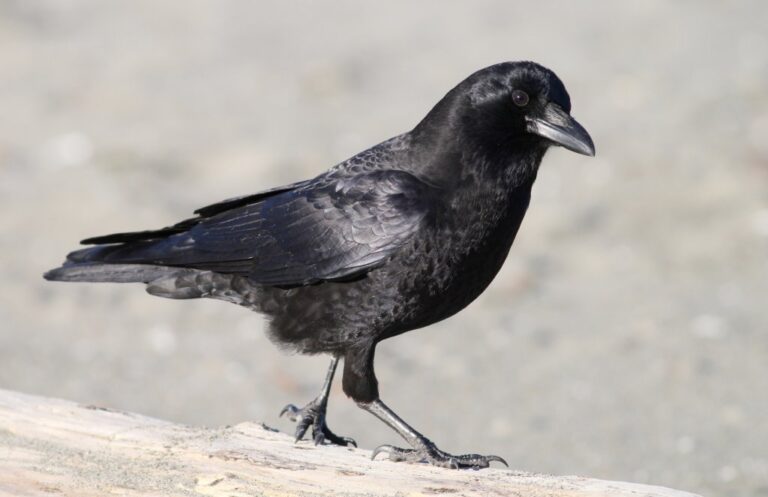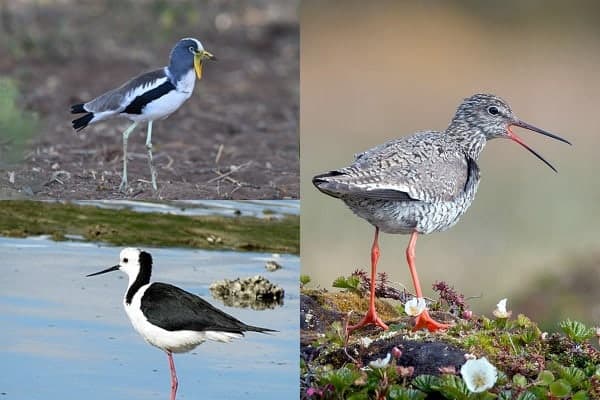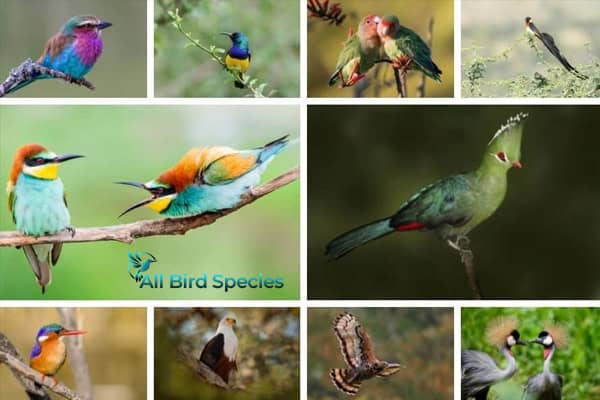23 Types Of Blackbirds (Icteridae) With Pictures
Blackbirds are a fascinating group of birds native to the Americas, belonging to the Icteridae family. They bear a striking resemblance to the Eurasian Blackbird, although they’re actually part of the thrush family. These New World blackbirds are equipped with long, slender bills, perfect for feasting on seeds and insects.
You’ll often find them foraging on the ground, although some species prefer the canopy of trees for their meals. In many species, males sport flashy black plumage with patches of vibrant color, while females tend to be more understated, with dull brown feathers. During winter, these birds often join forces to form large feeding flocks, sometimes mixing with other related species for company.
In total, there are 23 species of blackbirds, sorted into 14 different genera. Keep reading to learn more about each fascinating member of this diverse avian family
1. Genus Agelaius
1.1 Red-shouldered Blackbird (Agelaius assimilis)
The male Red-shouldered Blackbird exhibits striking features with its plain black plumage adorned by a mesmerizing bluish iridescence. Among its distinctive markings, a notable orangy-red shoulder patch, highlighted by a delicate yellow outline, serves as a prominent identifier. In contrast, the females, while sharing the same black hue, lack the glossy sheen of their male counterparts and do not display any shoulder patches.

The Red-shouldered Blackbird, recognized for its unique appearance and habitat, is primarily endemic to the lush landscapes of Cuba. Thriving amidst the serene environments of marshes, wetlands, and swamps, these birds contribute to the vibrant ecosystems of their native habitat. Their presence enriches the intricate web of life within these habitats, playing integral roles in local food chains and ecological balance.
1.2 Red-winged Blackbird (Agelaius phoeniceus)
The male Red-winged Blackbird is a striking sight during breeding season, boasting glossy black feathers with a vibrant yellow stripe along the wing and an eye-catching orange-red patch on the shoulder. Outside of breeding season, Icteridae plumage takes on a more subdued appearance, with rusty edges to the feathers and smaller shoulder patches.
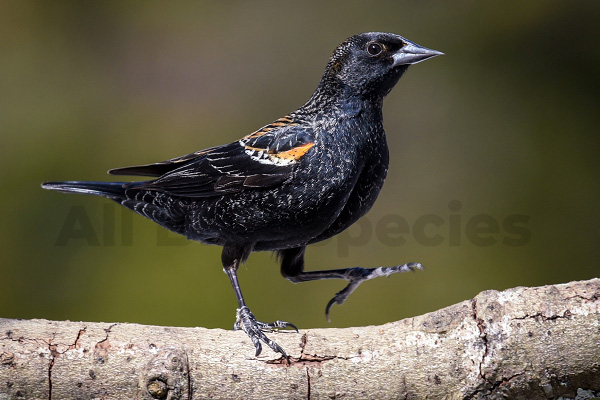
Females, on the other hand, sport a more modest attire, with plain brown upper parts and heavily streaked brown underparts. They also have pale eyebrows and small shoulder patches, albeit less pronounced than those of the males.
Red-winged Blackbirds are widespread across North America and much of Central America, earning the title of one of the most abundant bird species in the region. You can find these Icteridae inhabiting marshes and scrubby fields, where they make their homes and go about their daily lives.
1.3 Tawny-shouldered Blackbird (Agelaius humeralis)
The Tawny-shouldered Blackbird is known for its shiny black feathers and a pop of yellow-orange on its shoulders. While males and females look alike, the females have less shine and a smaller patch on their shoulders.
Moreover, these Icteridae family birds can be found in various places like forest edges, pastures, shrublands, and fields. But they’re not widespread; they mainly stick to Cuba and Hispaniola.
1.4 Tricolored Blackbird (Agelaius tricolor)
The Tricolored Blackbird is a petite black bird adorned with white stripes on its wings. During breeding season, the male boasts glossy black feathers, except for a striking orange-red patch on its shoulder.
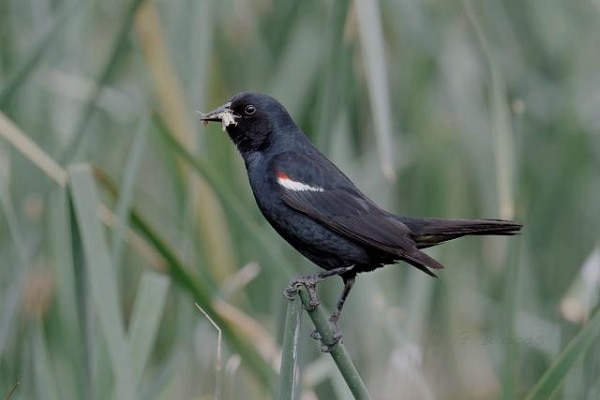
However, outside of breeding season, the males lose some of their luster and appear duller. As for the females, they sport a plain dark brown hue with streaks underneath.
Furthermore, these Icteridae birds can be spotted in marshes, wetlands, grasslands, and fields along the western coast of the United States and in Baja California, Mexico.
1.5 Yellow-shouldered Blackbird (Agelaius xanthomus)
The Yellow-shouldered Blackbird boasts a sleek black plumage, with its distinguishing feature being a vibrant yellow shoulder patch. Unlike some bird species, both males and females of this species share a similar appearance, characterized by their sleek black feathers and eye-catching yellow accents.

Endemic to the enchanting landscapes of Puerto Rico, the Yellow-shouldered Blackbird finds its home among the intricate ecosystems of mangroves and adjacent scrublands. Within these coastal habitats, they contribute to the rich biodiversity, their presence intertwining with the unique flora and fauna found in these regions. As vital inhabitants of these environments, they play essential roles in ecological processes, contributing to the balance and resilience of their delicate ecosystems
2. Genus Agelasticus
2.1 Pale-eyed Blackbird (Agelasticus xanthophthalmus)
The Pale-eyed Blackbird flaunts glossy black feathers and stands out with its pale yellow or white eyes. Interestingly, males and females look alike.

Moreover, these birds call wet grasslands and marshes home, particularly around oxbow lakes and lagoons. However, they’re only found in a limited area, mainly in Peru and Ecuador.
2.2 Unicolored Blackbird (Agelasticus cyanopus)
Male Unicolored Blackbirds are simple, sporting plain black feathers. However, the females display some geographical diversity, ranging from black-streaked brown to brownish-olive upper parts.
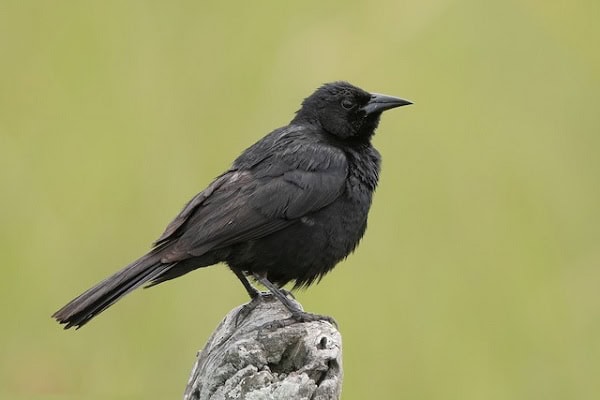
Additionally, their undersides vary from dark yellow to olive with streaks of brown. They’re adorned with a distinct yellow eyebrow stripe and a dark face mask.
Furthermore, these birds inhabit swamps, grasslands, and marshes, predominantly in the central regions of South America.
2.3 Yellow-winged Blackbird (Agelasticus thilius)
The male Yellow-winged Blackbird is easily recognizable with its black plumage and a distinctive splash of yellow on its wings, creating a shoulder patch.
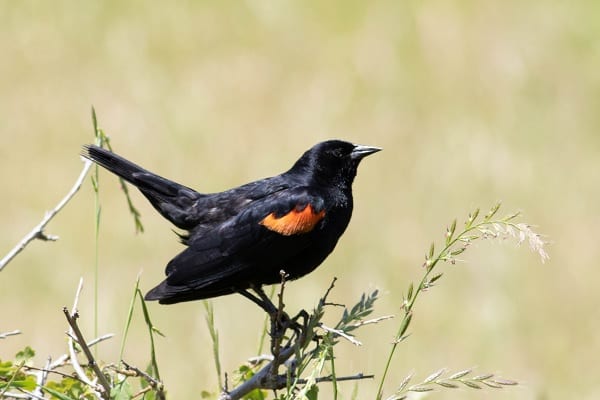
On the other hand, the female boasts dark brown upperparts, a subtle pale eyebrow stripe, a dark brown face mask, and a light brown underside adorned with dark streaks.
Moreover, these birds can be found in the southern regions of South America, preferring habitats such as wetlands, lake edges, swamps, pastures, and fields.
3. Genus Amblyramphus
3.1 Scarlet-headed Blackbird (Amblyramphus holosericeus)
The Scarlet-headed Blackbird is a stunning bird, featuring a striking orange-red head, neck, throat, chest, and thighs. Interestingly, both males and females share this vibrant appearance.
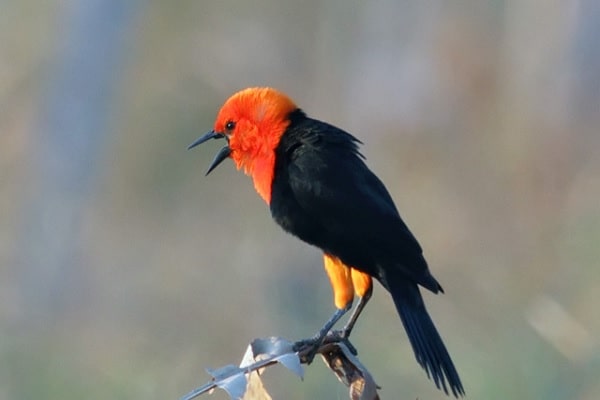
These beautiful birds typically reside in densely vegetated marshes. You can spot them in countries like Argentina, Paraguay, Brazil, Uruguay, and Bolivia.
4. Genus Anumara
4.1 Forbes’s Blackbird (Anumara forbesi)
Forbes’s Blackbird presents a sleek appearance with its entirety covered in black plumage, a characteristic shared by both males and females of the species.
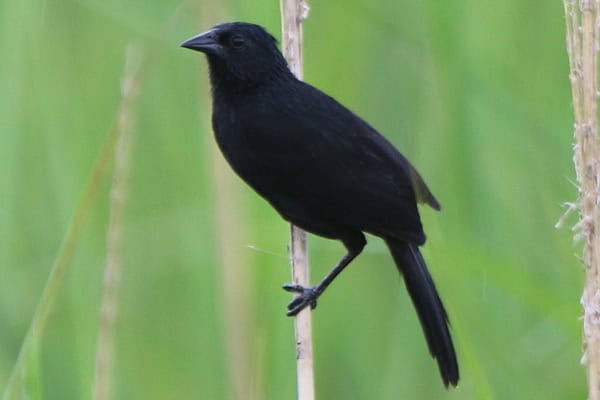
These birds inhabit a specific niche within the ecosystems of northeastern and eastern Brazil, where they can be found dwelling along forest edges, adjacent marshlands, flooded grasslands, and even amidst the vast expanses of sugarcane plantations. Despite their restricted range, Forbes’s Blackbirds play crucial roles within these habitats, contributing to the intricate web of life by foraging for food, dispersing seeds, and potentially acting as indicators of environmental health.
5. Genus Chrysomus
5.1 Chestnut-capped Blackbird (Chrysomus ruficapillus)
Male Chestnut-capped Blackbirds are quite the sight during breeding season, showcasing black plumage with distinctive chestnut coloring on their throat, forehead, and crown. However, outside of breeding season, their appearance changes to include olive-tipped feathers on their backs, flanks, and chests.
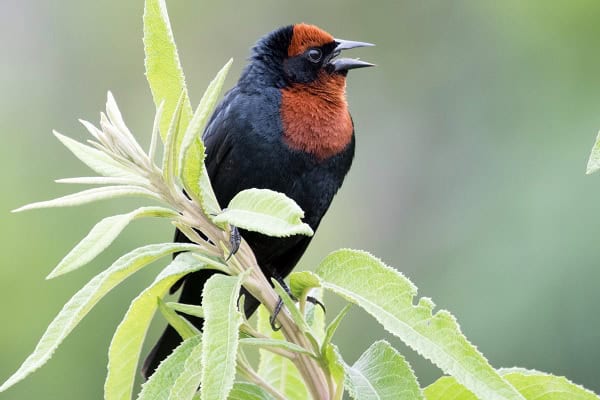
Conversely, females sport a dark olive-brown face and upper parts adorned with fine streaking. They also have a buffy throat and olive-brown underparts with dark streaks.
These birds make their home in wet grasslands, marshes, and agricultural lands. You can find them scattered throughout central-eastern South America.
5.2 Yellow-hooded Blackbird (Chrysomus icterocephalus)
The breeding male Yellow-hooded Blackbird stands out with its vivid yellow head, chest, and nape against a black body, making it easy to spot. However, during non-breeding season, they still retain their yellow hues, but with yellow-tipped chest and back feathers, along with an olive-yellow nape and crown.
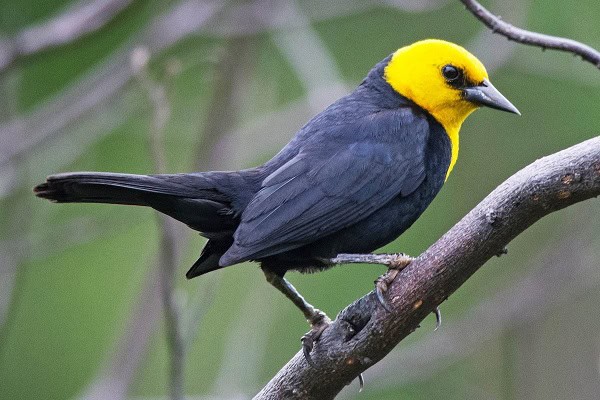
On the other hand, the female has a distinct appearance, sporting a yellowish head, a brighter yellow upper chest, blackish wings, and a dark olive-brown body with some streaking.
These birds are native to northern South America, preferring habitats like wetlands, marshes, areas around lakes, and riverbanks.
6. Genus Curaeus
6.1 Austral Blackbird (Curaeus curaeus)
The Austral Blackbird showcases a stunning glossy black plumage that covers the entire body, with both males and females sporting this striking appearance.
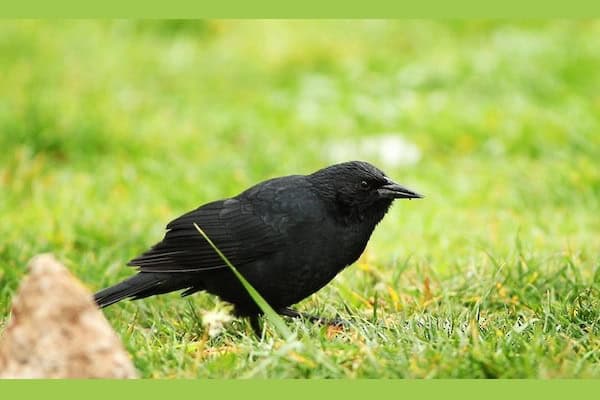
These adaptable birds are widespread across various habitats within the regions of Chile and Argentina. They can be found thriving in diverse environments ranging from farmlands and urban parks to open forests and scrublands.
Their ability to inhabit such a wide range of habitats speaks to their resilience and adaptability, allowing them to carve out niches in both natural and human-altered landscapes. As integral components of these ecosystems, Austral Blackbirds contribute to ecological processes such as seed dispersal, insect control, and maintaining biodiversity.
7. Genus Dives
7.1 Melodious Blackbird (Dives dives)
The Melodious Blackbird is known for its smooth, velvety black feathers, with no noticeable differences between males and females.
You can spot these birds in Central America, where they thrive in semi-open environments like open forests, agricultural areas, yards, and fields close to forests.
7.2 Scrub Blackbird (Dives warczewiczi)
The Scrub Blackbird boasts a sleek black appearance with a captivating bluish sheen that extends across its entire body. Notably, both males and females of this species share a similar visual profile, lacking distinct differences in plumage.
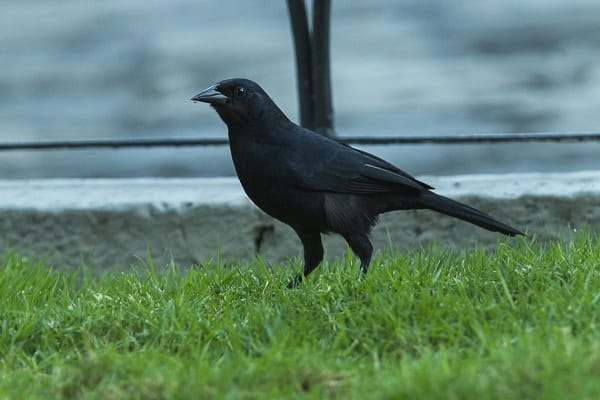
These birds find their habitat in the open expanses and lowland forests of western Ecuador, western Peru, and southwestern Colombia. Within these regions, they play essential roles in maintaining ecological balance and functioning. Their presence contributes to seed dispersal, insect control, and overall ecosystem health. As inhabitants of these diverse landscapes, Scrub Blackbirds showcase the adaptability and resilience necessary to thrive in varying environmental conditions.
8. Genus Euphagus
8.1 Brewer’s Blackbird (Euphagus cyanocephalus)
Male Brewer’s Blackbirds are quite the sight during breeding season, boasting glossy black feathers with a purple sheen on their heads, a greenish glow on their bodies, and striking yellow eyes. However, outside of breeding season, they sport a subtle pale eyebrow stripe.
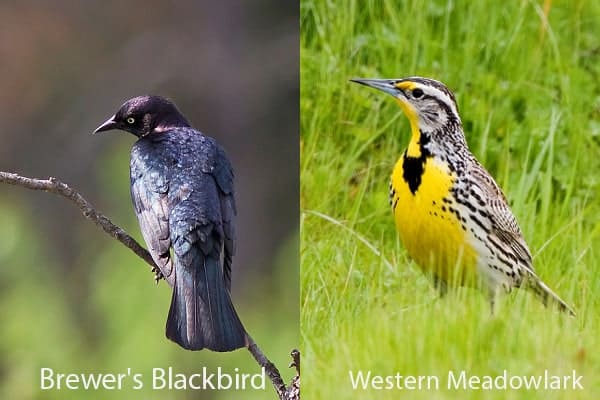
Conversely, females showcase dark brown plumage with a delicate purple gloss on their heads, a greenish sheen on their bodies, and a dark eye line.
These birds prefer open spaces like fields, farmlands, parks, and urban areas. You can find them across most of the United States, Mexico, and southwestern Canada.
8.2 Rusty Blackbird (Euphagus carolinus)
The breeding male Rusty Blackbird displays sleek black plumage with a glossy green sheen. However, during non-breeding season, they adopt a more subdued appearance, featuring a buff-brown eyebrow stripe, rusty-brown nape, crown, and ears, along with rusty edges to their feathers.

Their undersides are buff-brown with black barring, while the upper side is primarily brown with black rump, tail, and wings. One consistent feature is their yellow eyes, seen in all phases of plumage.
Females of the species are slate-grey with rusty feather edges, buff-brown eyebrow stripes, brown heads and chests, and dark upperparts showcasing a bluish-green gloss.
These adaptable birds can be found across much of North America, particularly favoring wooded swamps, bogs, shorelines, wet forests, cultivated areas, pastures, and fields.
9. Genus Gnorimopsar
9.1 Chopi Blackbird (Gnorimopsar chopi)
The Chopi Blackbird presents a striking appearance with its glossy black plumage covering its entire body. Remarkably, both males and females of this species exhibit a similar visual profile, lacking distinct differences in their plumage.

These adaptable birds inhabit a diverse array of habitats, including forest edges, woodlands, grasslands, savannas, and even agricultural areas. Their range extends across a significant portion of central and eastern South America, showcasing their ability to thrive in varied landscapes and ecosystems. Within these habitats, Chopi Blackbirds play important ecological roles, contributing to seed dispersal, insect control, and the overall health of their environments. Their adaptability and widespread distribution underscore their significance as integral components of South American ecosystems.
10. Genus Nesopsar
10.1 Jamaican Blackbird (Nesopsar nigerrimus)
Male Jamaican Blackbirds sport a striking appearance with entirely glossy black plumage. Interestingly, females closely resemble males in their appearance.
These Icteridae birds are unique to Jamaica and prefer to inhabit high-elevation, wet montane forests, and wet woodlands, showcasing their adaptability to specific habitats.
11. Genus Oreopsar
11.1 Bolivian Blackbird (Oreopsar bolivianus)
The Bolivian Blackbird presents a simple yet distinctive appearance with its plain black body complemented by brown wings. Interestingly, both Icteridae males and females share a similar visual profile, lacking distinct differences in their plumage.

These adaptable birds inhabit a variety of habitats within the Andes of Bolivia, including agricultural areas, woodlands, cactus forests, scrublands, and farming areas in dry valleys. Their ability to thrive in such diverse environments highlights their resilience and adaptability to varying ecological conditions.
Within these habitats, Bolivian Blackbirds play important ecological roles, contributing to seed dispersal, insect control, and the overall health of their ecosystems..
12. Genus Ptiloxena
12.1 Cuban Blackbird (Ptiloxena atroviolacea)
The Cuban Blackbird boasts glossy black plumage adorned with mesmerizing shades of blue, violet, and blue-green sheens, creating a stunning sight. While the female is slightly duller in comparison to the male, they still share similar characteristics.
These unique birds are exclusive to Cuba and can be spotted in a variety of wooded habitats, including wet forests, yards, parks, wooded cities, grasslands, open woodlands, fields, and even human settlements.
13. Genus Xanthocephalus
13.1 Yellow-headed Blackbird (Xanthocephalus xanthocephalus)
True to its name, the Yellow-headed Blackbird’s male counterpart stands out with its plain black body, adorned with a white stripe on the wing and a striking golden-yellow head, neck, and chest.

Conversely, females adopt a more understated appearance, with dark brown bodies, subdued yellow chests, and patchy black and yellow heads.
These distinctive birds are commonly found in western North America and Mexico, preferring habitats such as marshes, wetlands, meadows, and edges of rivers and ponds.
14. Genus Xanthopsar
14.1 Saffron-cowled Blackbird (Xanthopsar flavus)
The Saffron-cowled Blackbird exhibits a striking appearance characterized by its vivid yellow head, rump, shoulder patches, and underside, contrasting with the rest of its black body, including a distinct black face mask. Notably, females share a similar pattern with males but display brown feathers instead of black.
These captivating birds find their habitat in diverse landscapes, including grasslands, pastures, and marshes. Their range spans across a relatively small area encompassing parts of Argentina, Brazil, Paraguay, and Uruguay.
Despite their limited distribution, Saffron-cowled Blackbirds play vital roles within their ecosystems, contributing to seed dispersal, insect control, and the overall health of grassland habitats. Their striking appearance and ecological significance underscore the importance of conserving their habitats across their range.
Check Our Previous Articles
| What Eats Birds? A Comprehensive Guide |
| Blue Birds in Pa (Pennsylvania) |
| Cleaning Out Birdhouses: How Should You Remove Old Nest? |
| Black and White Birds |
Frequently Asked Questions About Blackbirds Icteridae
Q1: What are the characteristics of the Icteridae family?
The Icteridae family is characterized by medium-sized to large songbirds with diverse plumage colors, often featuring glossy black or iridescent feathers. Many species also exhibit bold markings and unique vocalizations.
Q2: Are icteridae carnivores?
No, icteridae birds are primarily omnivores, feeding on a diet that includes seeds, fruits, insects, and occasionally small vertebrates.
Q3: Is grackle an icterid?
Yes, the grackle is indeed a member of the Icteridae family, known for its iridescent plumage and distinctive vocalizations.
Q4: Where are the Icterids?
Icterids are found primarily in the Americas, ranging from Canada to Argentina, with the highest diversity in Central and South America.
Q5: What color is a female blackbird?
Female blackbirds typically have more subdued plumage compared to males, often displaying brown or gray feathers with less prominent markings



